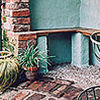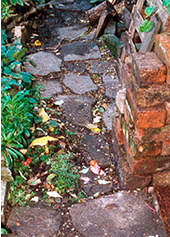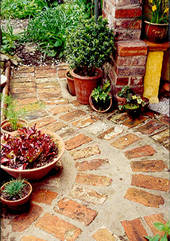Rustic plastering
The inside of the shed needed an enormous amount of work. Decades of dirt
and dust fell on my head. Half the shed was covered in old but basically
sound plaster, the other half was bare brickwork. I decided to use plaster
on this half also. I had to go through a range of appropriate wall-priming
procedures, and took guidance from books.
I'd never plastered a wall before and didn't really know what I was doing.
Luckily I needed only a "rustic" effect - and as I've come to
realise, "rustic" is a useful word for describing something
you've done that looks a bit crap.
The paving
In the New Year, 1999, after having a short break from the work for Christmas, I started work on the path in front of the shed, by this point mere rubble, having previously been a concrete path.
Bricks from the demolished wall were used to create the path in front
of the shed, as shown on the photo on this page. (And yes, it is supposed
to curve like that.) I spent a fair while playing about with patterns
for the brickwork, before realising I was tired of having a garden like
a building site and that I really did want to get it finished.
You may be thinking that it's not a good idea to use house bricks for
paths as they crack in the frost. I had read this, but then I had a load
of bricks to hand, and wasn't going to chuck them all out and get a load
more. Anyway, they looked right, having been in the garden, as part of
the shed, for over a hundred years already, Most of the paths in my garden
are made from such bricks, which have seen many hard frosts, and I've
had no major problems.
Why it was worth it
The remodelled outbuilding has been worth the effort. Victorian outbuildings
are as well-built as the houses themselves are, and look so much like
a continuation of the house - same weathered brick, and solid slate roof
- it seems a shame not to make proper use of them.
On rainy days Millennium Shed, with its slate roof, provides perfect cover,
while its open front and window in one side means a good view of the garden.
It gets little sun, as it faces north, but in the early morning the sunlight
shines in for a while through the east-facing window. It would be nice
if it faced south, but demolishing it entirely and rebuilding it on the
other side of the garden seemed rather too big a job.
Millennium Shed has proved to be a good place to sit on those damp mornings
and drizzly evenings. It's like being inside while you're outside.
In 2004, the section of the floor that was originally loose chippings was turned into solid floor, with a home-made mosaic made from broken crockery - described in a new page on this site: Memory Mosaic.



